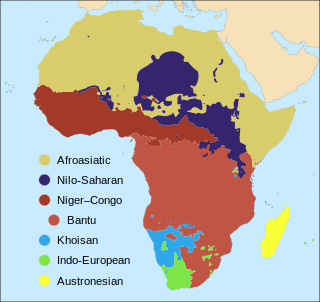Related Research Articles

The languages of Africa are divided into several major language families:

A wide variety of languages are spoken throughout Asia, comprising different language families and some unrelated isolates. The major language families include Austroasiatic, Austronesian, Caucasian, Dravidian, Indo-European, Afroasiatic, Turkic, Sino-Tibetan and Kra–Dai. Most, but not all, have a long history as a written language.

The Kwa languages, often specified as New Kwa, are a proposed but as-yet-undemonstrated family of languages spoken in the south-eastern part of Ivory Coast, across southern Ghana, and in central Togo. The name was introduced 1895 by Gottlob Krause and derives from the word for 'people' (Kwa) in many of these languages, as illustrated by Akan names.
Mpra, or Mpre, is an extinct language spoken in the village of Butei in central Ghana, located between the towns of Techiman and Tamale near the confluence of the Black and White Voltas. Mpra has been difficult to classify due to its divergent vocabulary. It is known only from a 70-word list given in a 1931 article. Blench (2007) considers it to be a possible language isolate. A poorly attested language spoken in the nearby village of Tuluwe, Mpur, may also turn out to be yet another language isolate. Both Butie and Tuluwe are located near the village of Mpaha.

Munichi is a recently extinct language which was spoken in the village of Munichis, about 10 miles (16 km) west of Yurimaguas, Loreto Region, Peru. In 1988, there were two mother-tongue speakers, but they had not met since the 1970s. The last known fluent speaker, Victoria Huancho Icahuate, died in the late 1990s. As of 2009 there were several semi-speakers who retained significant lexical, and partial grammatical, knowledge of the language.
The Yalë language, also known as Nagatman, is spoken in northwestern Papua New Guinea. It may be related to the Kwomtari languages, but Palmer (2018) classifies it as a language isolate.
Elseng is a poorly documented Papuan language spoken by about 300 people in the Indonesian province of Papua. It is also known as Morwap, which means "what is it?" ‘Morwap’ is vigorously rejected as a language name by speakers and government officials.

The Nara (Nera) or Barea (Barya) language is spoken by the Nara people in an area just to the north of Barentu in the Gash-Barka Region of western Eritrea. The language is often confused with Kunama, which is at best only distantly related.
Kunza is an extinct language isolate once spoken in the Atacama Desert of northern Chile and southern Peru by the Atacama people, who have since shifted to Spanish. The last speaker was documented in 1949.
The Siamou language, also known as Seme (Sɛmɛ), is a language spoken mainly in Burkina Faso. It is part of the Kru languages or unclassified within the proposed Niger–Congo languages. It is also spoken in Ivory Coast and Mali, and could likely be a language isolate.

ʼOle, also called ʼOlekha or Black Mountain Monpa, is possibly a Sino-Tibetan language spoken by about 1,000 people in the Black Mountains of Wangdue Phodrang and Trongsa Districts in western Bhutan. The term ʼOle refers to a clan of speakers.
Hatam is a divergent language spoken on the island of New Guinea, specifically in the Indonesian province of West Papua.
Pankararú is an extinct language of eastern Brazil. There are 6,000 ethnic Pankararú, but they all speak Portuguese. In 1961, only two elders could remember anything of the language. Today, they live in Brejo dos Padres and other villages of Tacaratu, Pernambuco State. The language was originally spoken between the Moxotó River and the Pajeú River.
Keuw is an unclassified language of New Guinea.
Buru and Angwe constitute a potentially rather divergent Southern Bantoid language spoken in Sardauna LGA, Taraba State of Nigeria.
Hruso, also known as Aka (Angka), is a language of Arunachal Pradesh India. Long assumed to be a Sino-Tibetan language, it may actually be a language isolate. It is spoken by 3,000 people in 21 villages in Thrizino Circle, West Kameng District. The Hruso people inhabit areas of South East Kameng and are concentrated in the Bichom River Valley, and speak English, Hindi, and Miji in addition to Hruso.
West Damar, or North Damar, is an Austronesian language of Damar Island, one of the Maluku Islands of Indonesia. In spite of rather low cognacy rates with its neighboring languages, it can be classified as part of the Babar languages based on qualitative evidence.
Dompo is an endangered language of Ghana. Speakers are shifting to Nafaanra. It is spoken adjacent to the main town of the Nafaanra people, namely Banda, Brong-Ahafo Region, Ghana. Blench (2015) reports that it is spoken by 10 households.
Notsi is an Austronesian language spoken in New Ireland, Papua New Guinea. It is spoken in eastern coastal villages among Kuot, a language isolate.
Nasal is an Austronesian language of southwestern Sumatra. Anderbeck & Aprilani (2013) consider Nasal to be an isolate within the Malayo-Polynesian branch. Smith (2017), though, includes the language in the "Sumatran" subgroup, alongside other Batak–Barrier Islands languages.
References
- ↑ Blench, Roger (2007) Recovering data on Mpra (Mpre) a possible language isolate in North-Central Ghana